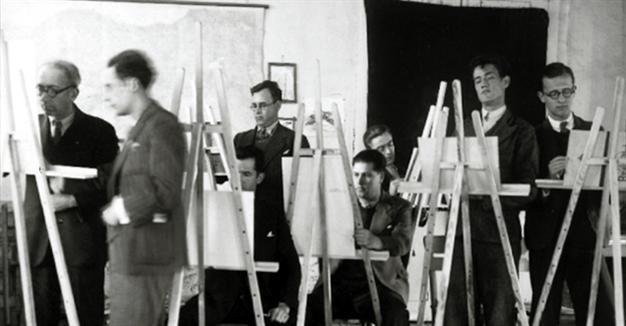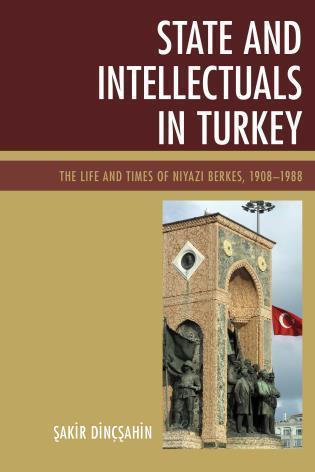The life and times of Niyazi Berkes, 1908–1988
William Armstrong - william.armstrong@hdn.com.tr

Niyazi Berkes spent two years working for the ‘People’s Houses,’ set up by the republican authorities to spread Kemalist reforms to all four corners of Anatolia.
‘State and Intellectuals in Turkey: The Life and Times of Niyazi Berkes, 1908–1988’ by Şakir Dinçşahin (Rowman, $80, 186 pages)This useful new book uses the life of Turkish intellectual Niyazi Berkes as a window to explore the turbulent times through which he lived. The author Şakir Dinçşahin, an associate professor at Istanbul’s Yeditepe University, has written a volume full of details that enrich our understanding of the period, covering a life that spanned the Ottoman and republican eras.
 Berkes was born in Cyprus in 1908, the same year that the Young Turk revolution in the Ottoman capital restored constitutional rule and vowed to usher in multi-party politics. The questions of legitimacy, constitutional rule, and modernization would exercise Berkes throughout his life. As Dinçşahin writes, “an intellectual personality is the outcome of the political and social context surrounding an individual.” Berkes certainly lived through interesting times.
Berkes was born in Cyprus in 1908, the same year that the Young Turk revolution in the Ottoman capital restored constitutional rule and vowed to usher in multi-party politics. The questions of legitimacy, constitutional rule, and modernization would exercise Berkes throughout his life. As Dinçşahin writes, “an intellectual personality is the outcome of the political and social context surrounding an individual.” Berkes certainly lived through interesting times.He enrolled in the Istanbul School for Boys and then in 1928 the Darülfünün (later Istanbul University) – the two most prestigious schools of the imperial education system. In the early republican years Istanbul University was still dominated by traditional-minded Ottoman-era professors. But as a law and philosophy student Berkes became preoccupied with the question of how Kemalist reforms could penetrate more deeply through the education system and how the modernizing Turkish Republic could develop more equitably.
His first professional experience after graduating came with the People’s Houses, which the regime set up across Turkey to spread republican values by providing education and state-approved cultural services. Between 1932 and 1952, 478 People’s Houses and 4,322 People’s Rooms (in villages) were opened. Berkes was in charge of establishing the central library of the People’s Houses in 1932 and 1933, giving him a broader perspective on Turkish society, villages, modernization, secularism and nationalism.
Though ambitious, the People’s Houses were largely a failure, unable to transform the mindset of provincial citizens in line with Kemalist ideals. As Berkes recognized, in most places the Houses simply became “center[s] for the cultural entertainment of the urban social classes nostalgic for village life.” He also saw this failure as inevitable: It would be impossible to achieve the regime’s ambitious goals with a single step of revolution. But Berkes continued to believe that “the Kemalists would gradually succeed in transforming society as a whole and he sincerely wanted to contribute to this grand transformation.”
Among the reasons for the People’s Houses’ troubles were deep ideological divisions within their ranks. Conflict was fierce between right- and left-wing administrators, with both sides constantly complaining and issuing reports about each other. The 1930s are usually seen as the apogee of single-minded Kemalist authoritarianism, but in fact all of Turkey’s state institutions were riven by fierce ideological divisions. The regime tried to maintain an image of uncompromising revolutionary authority but bitter ideological divides were often bubbling away under the surface. We tend to think of angry left vs. right tugs-of-war in Turkey as characteristic of the 1960s and 70s in particular, but this book shows they have a much longer heritage.
Those schisms were exacerbated after the death of Atatürk in 1938. In the words of Dinçşahin, two ideological groups competed against each other in the formation of a new version of the official ideology: “On the one side, an ultranationalist or even racist group of intellectuals, politicians, and army officers coalesced under the influence of Nazi ideology … On the other side a new group of progressive politicians and intellectuals that adhered to liberal, anti-racist, humanitarian, leftist, socialist, and even communist worldviews.”
The divide continued throughout the Second World War. Throughout the war President İsmet İnönü tried to maintain a delicate defensive balancing act of “active neutrality.” He utilized left-right polarization to show that newspapers, magazines, and books supporting both sides of the war could find a place in the press, thereby demonstrating Turkey’s neutrality. However, according to Dinçşahin, “Turkish policy on neutrality always intended to favor the ultimate winners of the war rather than strict impartiality. As the war progressed, the position of the Turkish government changed in accordance with the ebb and flow of the war.” As a result, Ankara allowed and even encouraged the activities of ultranationalists between 1941 and 1943, when a German victory looked highly probable. The government stopped tolerating this group only when the defeat of Germany became visible after Stalingrad. Turkey finally joined the Allies in February 1945, when it was all but certain that the Axis powers would be defeated.
Berkes was firmly in the leftist camp throughout the war, supporting Britain and the Soviets and opposing Nazi influence. But after 1945 international dynamics had big ramifications on Turkey’s domestic politics: In the early Cold War years, when Turkey leaned West against the perceived Stalinist threat, left-wing Kemalist intellectuals came under intense scrutiny. At a time when the Soviets were said to have territorial designs on eastern Turkish provinces, any whiff of leftism was anathema to the CHP regime. In 1946 the government launched an anti-communist campaign. Ultranationalist pan-Turkist groups organized violent protests against leftist individuals and institutions, including mob attacks on newspapers and journals. Academics were targeted and professors were removed from their posts. As a prominent left-wing public intellectual employed by Ankara University, Berkes was not immune from the witch hunt. The Education Ministry accused him of “poisoning Turkish youth” with foreign ideological propaganda and cut his contract. His appeal was still ongoing in 1952 when he decided to leave for voluntary exile after being offered a teaching position at McGill University in Canada.
Berkes’ academic focus included work on modernization in the Ottoman Empire and Turkey, secularism, history of religion and Islam; his book “The Development of Secularism in Turkey” remains on Turkish undergraduate courses as a set text. Berkes’ life may have followed the fairly ordinary trajectory of a moderately successful academic, but Dinçşahin’s book shows that it is a good prism through which to consider important questions of 20th century Turkey.










